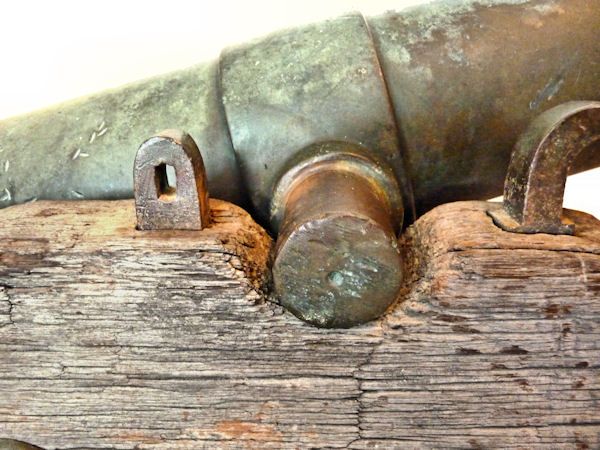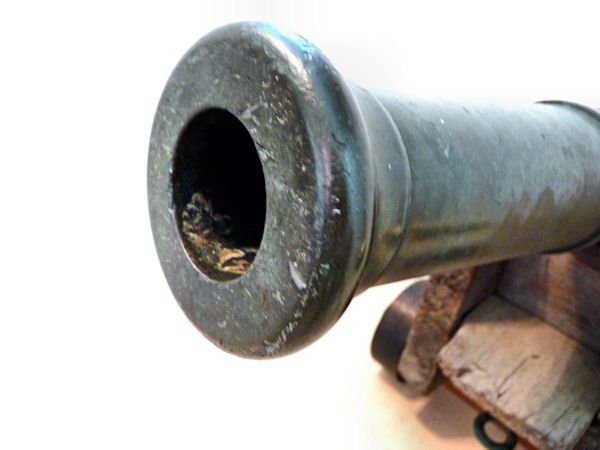Here is an exceptional, full size, cast bronze cannon in a style that was
used by both Naval and Merchant ships in lieu of using their fighting guns for signaling. It is decidedly American in
its design and the quality of its workmanship. The barrel is mounted on its original carriage and has its original bronze
hardware including an elevation turntable under the cascabal. The barrel has a rich mottled green patina that varies
in color over half its surface. The remaining surface varies in shades of dark brown to black. There is a prominent touch
hole just behind the third reinforcing ring. Based on all the information we have studied, we date this cannon to the first
quarter of the 19th Century.
of this type were used for the purpose of making signals which included saluting other vessels, to announce arrival
at a port, to sound a mutiny, and when in fog. Their echo could be used in estimating distance off a shoreline. They also were use to start yacht races.
The features which mark this as an early and
authentic signal cannon of the first quarter of the Nineteenth Century are:
- Prominent cascabal knob
- Reinforced chamber
- Low line trunnions
- Iron trunnion caps
- five reinforcing bands
- Original Teak wood carriage
We have sold many small salute and signal cannons that were very popular in 18th and 19th
Century being used both ashore and afloat and also some full size cannons, but this is the first full size signal that we
have the pleasure to offer.SIGNIFICANCE OF TRUNNION PLACEMENT: Trunnions are the
cylinders projecting from the side of the tube. They were first introduced in cannons in 1705. Their placement on
the barrel helps to date when the cannon was made. Before 1725 they were located low down as in this case. 1725, is when
the so-called Cronstedt system was established. After the Cronstedt system was established, trunnions were placed at the
middle of the tube just forward of the center of mass. Based on the location of the trunnions, it can be concluded that most
cannons with this placement were likely cast before 1725. When it comes to the building material of the cannons, the Cronstedt
system focused on those made out of iron only. Since this cannon is of bronze the dating is not entirely conclusive and
we beleive ot was made during the first quarter of the Nineteenth Century.
Touch hole

Lower placement of trunnion – Cap removed
IRON VS BRONZE in MAKING CANNONS:
Early iron was not up to the requirements of cannons which is what made bronze the metal of choice. Bronze had greater
tensile strength than iron and could withstand greater bore pressures, and was corrosion resistant. It also allowed for
decorative motifs. It also was much more expensive and repeated firing could cause overheating and deformation.
With improvements in casting and and the quality of iron, bronze gradually fell
out of favor. According to Gardiner (1992) by 1781 only The Royal George of Britain had bronze armament. Paradoxically France
began producing bronze 18 pound guns for a new class of frigate in the same year. The French also used bronze field guns during
the French Revolution. Samuel E. Kimpton in his study of Naval Ordnance in the 18th Century states that he believes, the
typical naval gun of this period was iron and would remain so until the introduction of steel in the latter part of the 19th Century.
Two inch bore

Wheels held by brass washer & drift pin
Three quarter front view with trunnion cap on
BARREL DIMENSIONS:
Length overall
37″ Length
of barrel: 32 7/8″ Bore 2″
Width at rear
5″ Width front reinforcing band at muzzle 3″Width Trunnions 9″ Estimated
Weight 100 lbs
DIMENSIONS CARRIAGE:
24″ LOA x 18″ W x 13 1/2″ W Estimated
Weight 65 pounds
Total Weight 165 poundsCONDITION: The barrel of this cannon
shows the normal marks of age and use. There is a small chip of bronze missing from the muzzle cap on the right side and a
series of superficial dings on the middle of the breech also on the right side. Half of the barrel has a green patina of age
in varying shades and half of the barrel has a deep brown patina. It is possible that it may have been in sea water some time
in the past. The carriage is felt to be original, and it’s wood also may have been in sea water since many of its
grain is worn away. A repair has been made replacing a plank of wood at its trail. Two bronze nuts are replacements.
It is in good, strong condition.This cannon is an antique and is being offered for display only and should
not be fired.
MINOR ASSEMBLY REQUIRED: Because of its weight
this cannon will be shipped in two cartons and some simple assembly using a wrench will be required. Details will be
furnished.




